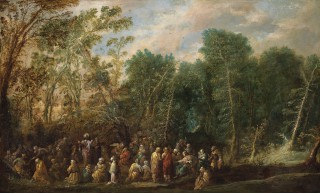Jesus Feeds the Five Thousand
- Date
- 17th c.
- Object type
- painting
- Technique
- oil
- Material
- copper
- Dimensions
- 23,3 x 38,1 cm
- Acquisition date
- 1792
- Location
- The Palace on the Isle - Picture Gallery, ground floor
- Marks and inscriptions
- signed L (?) M W to the right, on the trunk of the tree
- Place of Origin
- Germany (Europe)
- Owner
- The Royal Łazienki
- Museum number
- ŁKr 939
The monogram [L M W] was first recorded by Stanisław Iskierski (Katalog galerii obrazów Pałacu w Łazienkach w Warszawie, Warsaw 1931, no. 183), who believed the monogrammist to be a representative of the Flemish school from the late 16th century; in the 1967 catalogue of the National Museum in Warsaw the painting is dated to the turn of the 16th/17th century. …Iskierski (1931, p. 60) published a facsimile of the signature; the facsimile was also included by Tadeusz Mańkowski (Galeria Stanisława Augusta, Lwów 1932, no. 1811), although in a slightly different form: deciphered as ‘D M W’. From an enlarged digital photograph of the signature it transpires that the letter L may be interlaced with another letter, forming a ligature.
The horizontal composition of the landscape, with no diagonals and the view almost completely closed by the trees of the wood, with no opening-up, dates the painting to the 1630s or 1640s rather than the early 17th century. The sketchy, loose manner, particularly in the rendering of the staffage, is not typical of Netherlandish art dating from c. 1600 and of the circle of Jan Brueghel the Elder (where the figures are finely, precisely defined), but brings to mind the art of Central Europe and Germany. We cannot rule out that this is, in fact, a later imitation—according to Rüdigier Klessmann …or a pastiche of late manneristic landscape, not earlier than from the mid-17th century. … [D. Juszczak, H. Małachowicz, The Stanisław August Collection of Paintings at the Royal Łazienki. Catalogue, Royal Łazienki Museum, Warsaw 2016, no. 75, p. 288.]





